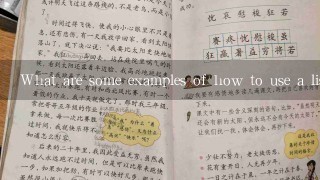What are some examples of how to use a list in the classroom?

Lists are useful for organizing and presenting information.一杯糖水、两份汤圆和三个水果是一道美味的甜品。 这是一篇关于如何使用列表在教室里教学的文章。 Lists can be used to introduce new concepts organize complex topics into manageable chunks or to create a visual representation of data. For example if you are teaching a unit on the climate you could make a list of important facts and definitions for students to refer to. You could also use lists to introduce new words in language lessons or to help students remember important dates or events in history.
Lists can be used in many different ways in the classroom such as 衣橱列表:让学生在列表上写下他们最喜欢的衣服。2。美食列表:给学生列出一些食物,请他们选择其中一种或多种进行制作。3。书单:给出一本好书的列表并鼓励学生阅读其中几本。4。愿望清单:列出想要实现的重要目标和梦想,并在教室中讨论如何实现它们。5。音乐列表:让学生写下自己最喜欢的歌曲、歌手和音乐类型,然后让他们互相分享。通过使用这些方法,学生们将学习如何组织信息以及思考他们的兴趣并与他人分享
There are several ways that lists can be used in the classroom.隔空取物,列举和比较等等。
Some examples of using lists in the classroom include 务虚张声势 - 让学生以小组形式在黑板上创建一个列表,然后讨论如何使用这个列表来完成特定任务 分类和排序 - 将各种事物按类别或大小排序 做比-较 - 列出两组数字的列表并比较他们的大小 进行统计分析 - 为一组数据创建列表并对其进行分析
在教室中,列表可以用来记录学生的姓名、座位或学习习惯。正是这些小东西,可以使教师更好地了解每个学生并制定有针对性的教学计划和策略。另外,老师也可以使用列表记录每名学生的作业完成情况和成绩排名以便及时发现问题并且进行适当的帮助措施。此外,学生也可以根据自己的特点和需求来创建自己的清单,以记录有关学习习惯、阅读兴趣点等内容的信息,这将极大地提升他们的学习成绩和学习效果。
In the classroom a list can be used for many different purposes.‾᷄ ⁻̵̶̡̩s‾̱̀́ʃ⁰꒱ᵉ 예.
在教室里使用列表有很多方式。仁慈的老师可以为一个学生指定一份清单,列出他/她的任务和需要完成的作业。这有助于老师更好地管理他们的课堂环境并确保学生按时完成它们的任务。另外,列表还可以用来组织班级活动和其他集体活动所需的物品或材料。教师在进行课程讲解时也可以使用列表来帮助学生记住重要的事实、原理或其他信息。此外,教师可以创建自己的清单,用于记录每个学生需要改进的内容和建议以及如何更好地指导他们学习新知识与技能的方法。最后,小学生们通常会在老师之前列出一个问题簿以跟踪他们的进展情况并获得反馈意见。
Lists can be used to organize information tasks or activities.一笑笑。Lists can also be used for guided reading where students refer to lists as they read and respond to questions. They may draw pictures to represent their understanding of the text or fill in graphic organizers with key ideas from the reading. Lists can also be used for group work where students work together to create a list that summarizes important information from a lesson or to brainstorm ideas and solutions to a problem.Lists can even be used to demonstrate math skills by having students list out the steps required to solve a problem for example.Overall lists are versatile teaching tools that can be used in many different ways to engage students in learning.





































































